Top News
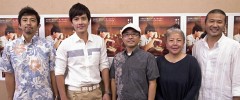
August 12, 2012 Ryukyu Shimpo
On August 10, at the Okinawa Prefectural Office, a press conference for a movie entitled Penguin Fufu was held with the actual couple and members of the cast present. The movie tells the story of their bond as a married couple and depicts many interesting episodes from their life together. When Airi, who hails from Tokyo, married her husband Gyoko, who is from China, she assumed his surname, “Penguin,” (actually “Pengin”) and they moved to Ishigaki. The movie filmed there includes many scenes featuring local food and introducing Ishigaki cuisine.
During the press conference, Airi said that neither the sesame oil nor her or her husband could be there without the people of Ishigaki, and its beautiful natural environment. She said, “I hope that people who see the movie sense the kind and generous nature of the Okinawan people.”
Eiko Koike plays the role of Airi, and Kingone Wang from Taiwan plays Gyoko. Okinawans such as Tomoji Yamashiro also act in the movie. Director Katsutoshi Hirabayashi said, “This is a unique movie in that the actors are from Taiwan, Tokyo, and Okinawa, and the movie was filmed entirely in Ishigaki. I really do hope many people go to watch it.”
The Okinawa Prefectural Office put 23.8 million yen towards the total production cost of 68 million yen.
They hope to make 100 million yen at the box office. On October 20, the movie will be screened at approximately 50 movie theaters across the country, but there will be an advance screening on Ishigaki Island on October 13.
(English translation by T&CT, Megumi Chibana and Mark Ealey)
Go to Japanese
August 15, 2012 Hideki Matsudo of Ryukyu Shimpo reports from Washington D.C.
On the topic of the Futenma relocation issue, in his report published in June 2011, Bruce Klingner, a senior research fellow for Northeast Asia in the Asian Studies Center at the Heritage Foundation, suggested that “Tokyo must make clear that Japanese national security and Asian peace and stability trump local Okinawan convenience.” He also urged the Japanese government to make it clear to Okinawa that Japanese government expenditure on Okinawan development is conditional on the Futenma Relocation Facility being implemented. It is quite possible that these recommendations may have influenced the Okinawa policy of the Japanese government.
In his report entitled, “Top 10 Reasons Why the U.S. Marines on Okinawa Are Essential to Peace and Security in the Pacific,” Klingner, a former senior analyst at the CIA, emphasized that the U.S. Marine Corps stationed in Okinawa has an important role to play in the defense of Japan, including the Senkaku Islands.
With regard to the reaction to his report, in his interview with a reporter of the Ryukyu Shimpo, he said, “I got a number of compliments from Japanese officials. A lot from the Ministry of Defense and from legislators. I got a number of compliments, both from Tokyo and Washington, and U.S. presence in Okinawa. Some of the senior Japanese officials said that paper was very helpful, because it helped to explain to us things that they had been trying to explain to the Japanese and the Okinawan people. So, a couple of those people took copies of the paper, saying that they would use it to try to better articulate the reasons for, not only the Marines, but the forward-deployed presence.”
With regard to the fateful pledge by the Democratic Party of Japan (DPJ) to relocate the facilities currently at the Futenma base outside of the prefecture or abroad Klingner said that, “Such a shift, the DPJ proclaimed, would require reducing Japan’s overreliance on the United States, demanding an equal alliance with Washington, and initiating a closer embrace of Asian nations, particularly China,” and he added, “Beijing’s aggressive behavior [the Senkaku’s incident] and Pyongyang’s attacks on South Korea eventually led to a belated DPJ epiphany about geostrategic realities.” He suggested that the DPJ’s stance of demanding an “equal alliance” with Washington ended in failure.
He also revealed that a Japanese official had commented that, “The crisis over the Senkaku Islands has beefed up Japan’s relations with America again.”
In his report he suggested that, “The Obama Administration should increase its public diplomacy efforts to convince the Japanese and Okinawan legislators, media, and public that the U.S. military presence is critical to the security of Japan.” Furthermore, he recommended that the Japanese government speed up the relocation of Futenma Air Station within the prefecture, pointing out that “Seeking understanding and consensus has its limits.”
(English translation by T&CT, Mark Ealey)
Go to Japanese
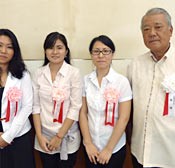
August 7, 2010 Ryukyu Shimpo
On August 1, the opening ceremony for the 27th South America Youth Internship was held at Ginoza Village International Exchange Center. Its goal was to welcome three young people from Argentina, Brazil, and Peru who are descendants of migrants from Ginoza Village.
This year’s interns are a fourth-generation Okinawan from Peru, Andrea Sayuri Nakasone Yara; a second-generation Okinawan from Argentina, Gabriele Shinzato, and a third-generation Okinawan from Brazil, Fernanda Hiromi Iha. Through until the end of October, they will learn about making sanshin, dance, and shishimai (or lion dance).
At the opening ceremony, Mayor Hajime Azuma encouraged them to draw upon their pride as Ginozanchu to learn and devote themselves to the community.
Yara said, “I would like to learn about the sanshin, to make many friends and to talk to people about Peru.” Shinzato, whose father and sister were also interns in the past, said, “I am so happy that my dream to come to Okinawa has actually come true. I want to learn about Okinawan culture and to meet many people while I’m here.” Iha said, “My grandfather was born in Ginoza. I’m very grateful for the opportunity to be able to stay here for three months while I study dance.”
The internship program started since 1986. To date, the Ginoza Municipal Office has accepted 85 interns.
(English translation by T&CT, Megumi Chibana and Mark Ealey)
Go to Japanese
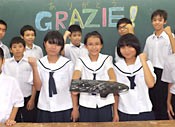
August 6, 2012 Ryukyu Shimpo
An engineer team from Modena in Italy that participated in the World Solar Challenge race held in October 2011 in Australia presented a model car to Team Okinawa, the first Okinawan team to take part in the world’s largest solar-powered car race. The model car was made using exactly the same design and materials as the car that competed in the actual race and it represents the engineers’ desire to wish each other good luck and to look forward to a reunion at next year’s race.
The manager of Team Okinawa, Satoru Izuka, and the pupils of the engineering club that is also a member of Team Okinawa, accepted the model.
Yuri Inafuku, a first year student at Ozato Junior High School said, “I was surprised that the model car is so light and that it looks so good.” Ryuki Tamashiro and Ayumu Yabiku, second-year students hoping to take part in next year’s race, said, “We are very pleased to be encouraged like this by people from overseas. By honing our skills to the same level as our seniors, we would like to do our best for the people in the local community and for the companies that have supported us.”
(English translation by T&CT, Lima Tokumori and Mark Ealey)
Go to Japanese
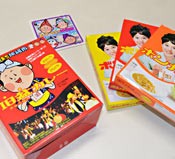
August 3, 2012 Ryukyu Shimpo
From August 13, the Okinawa City Tourism Association and Otsuka Foods, a company producing the Japanese well-known retort-pouched goods Bon-curry, will sell a jointly planned product called Kyu-bon curry.
The Bon-curry is sold in Okinawa as a limited edition, using the same packaging that was first designed featuring an image of the Japanese actress Yoko Matsuyama. The new product was named after Bon-curry and kyu-bon, the bon festival of the lunar calendar. It aims to project Okinawa City as the home of eisa, the Okinawan traditional dance performed in the kyu-bon season. The price is 715 yen for a set of three levels of hotness, mild, medium and hot. The package of the set box features a character for eisa, Sa-chan, instead of Matsuyama. Part of the profit will be donated to activities designed to develop the eisa community.
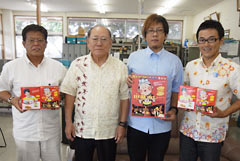
On August 2, at the Ryukyu Shimpo’s Chubu office, staff of the Okinawa City Tourism Association and Otsuka Foods promoted Kyu-bon curry to project Okinawa City as the home of eisa.
On August 2, the head of the association, Tomikichi Nakamura, and Kazuhiko Horiuchi, who is a public affairs manager at Otsuka Foods, visited the Ryukyu Shimpo’s Chubu office. They commented how this is a combined effort designed to convey Okinawan traditional arts and tastes to future generations.
The Kyu-bon curry will be sold throughout the year at a shop called Eisa-ya, in Music Town Oto Ichiba in Okinawa City. For further details, call the Okinawa City Tourism Association at 098 (989) 5566.
(English translation by T&CT, Lima Tokumori and Mark Ealey)
Go to Japanese
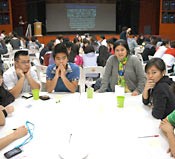
August 6, 2012 Akiko Yasuhara, Correspondent of Ryukyu Shimpo
The 1st Worldwide Youth Uchinanchu Festival Brazil 2011, started in Sao Paulo on July 25 with about 150 people from seven countries participating in the five-day long event. The participants were mainly young Uchina in their teens and 30s who are now living overseas. They discussed things such as how can societies of Okinawan descendants best pass on Okinawan culture, and the creation of a database to allow Uchinanchu all over the world to share relevant information.
As evidenced by many of the participants commenting that they were able to make valuable contacts, this festival represents a new movement in which the young standard bearers of Okinawa’s future can come together from countries all over the world to engage in meaningful dialogue. The discussion on this occasion centered upon the creation and use of networks, and the passing on through the generations of matters of cultural significance, but there were many young people who were interested in issues surrounding the U.S. military bases, so in future festivals that issue will undoubtedly be one of the topics for discussion.
I’m also Uchinanchu, born and raised in Okinawa. I have lived outside Okinawa since I graduated from high school but still feel the same passion towards my home as the overseas descendants whom I saw at the festival. Now I’m 35 years old, and had many opportunities to talk with other young Uchinanchu about the future and about what the leaders of Okinawa should be like. I feel uneasy to think that the circumstances surrounding the U.S. military bases in Okinawa have not changed in the two decades since I left the prefecture.
The Worldwide Youth Uchinanchu Festival will be held every year until the 6th Worldwide Uchinanchu Festival in 2015. I look forward to seeing what impact the global network and the energy generated through the youth festival will have on the present and future of Okinawa. I participated in the event in order to carry out interviews, but I was reassured to meet so many capable young Uchinanchu leaders from countries all over the world.
(English translation by T&CT, Lima Tokumori and Mark Ealey)
Go to Japanese
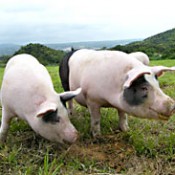
August 4, 2012 Maki Nagamine of Ryukyu Shimpo
Meat distributor Maruichi Meat is about to commence regular supply of agu pork, a traditional breed of Ryukyuan pig, to the Sogo Department Store in Hong Kong. Maruichi Meat has exported agu pork to Hong Kong in the past, and this latest supply arrangement is expected to boost the annual volume of supply to supermarkets and departments by 1.5 times the previous level. The president of the company, Zenei Yogi, said, “This represents an opportunity to expand exports of Okinawan meats not just for our company, but for meat suppliers throughout the prefecture. In future we hope to broaden our sales routes in Singapore and Vietnam.”
Since last year, the company has been exporting their original pork brand of Aged Agu Pork and Okinawa Meat Center’s pork brand of Okinawa Agu, a total of 120 kilograms (264.6 pounds) per month to Citysuper, an upscale supermarket operating four stores in Hong Kong. They closed the deal with Sogo Hong Kong in mid-July and started exports from the end of the month. In future they will export 60 kilograms (132 pounds) of Okinawa Agu per month.
According to the Okinawa Meat Center, Okinawa Agu contains a good quantity of glutamine acid, which is a component of the savory flavor. It has plenty of fat and a low melting point, so you can enjoy the sensation of the meat seemingly melting in your mouth.
They have negotiated a two-year deal. In the background to the completion of the deal is that because imports of black Iberian pig from Spain to Sogo Hong Kong have decreased, the store has been looking for products to take the place of the Iberian pig and offered Maruichi Meat the opportunity to export the pork. Sogo Hong Kong has two stores in Hong Kong but Maruichi Meat will supply pork to the Causeway Bay store in downtown Hong Kong.
In addition to agu pork, Maruichi Meat plans to export the Okinawa Livestock Promotion Public Corporation’s Masan Pork. Because its price is 30 to 40% lower than agu pork, they are looking to supply Masan Pork to general supermarkets.
Sadanobu Oshiro, the managing director of Maruichi Meat, said, “We export agu pork as a premium brand and we will develop sales by monitoring trends in the Hong Kong meat market.”
(English translation by T&CT, Lima Tokumori and Mark Ealey)
Go to Japanese
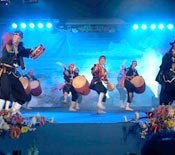
July 31, 2012 Akiko Yasuhara Correspondent of Ryukyu Shimpo
On July 29, at the Brazil Okinawa Cultural Center in Sao Paulo, a local festival was held bringing the 1st Worldwide Youth Uchinanchu Festival 2012 to an end. A total of 150 young people from seven different countries celebrated the festival being held for the 25th time.
During the performance of the Ryukyu Koku Matsuri Daiko Brazil branch in the early part of the festival, other members of overseas branches such as the United States and Argentina joined in to dance eisa together. A total of 300 people, the largest-ever number of performers at the branch, beat drums with vigor under the clear sky and an electric air to the people dancing kachashi. The Ryukyu Stomp, a dance group made up of members of the World Youth Uchinanchu Association Okinawa branch, expressed the history of Okinawan immigrants in their performance, moving to the mixture of Ryukyuan folk songs and techno music. The audience cheered and whistled in support.
In the main event, there was a beauty pageant held in Ryukyuan dress, with participants from the three branches of Okinawa, Bolivia and Peru appearing in traditional Ryukyuan costume wearing large floral-shaped hats. Aya Toyosato from the Okinawa branch was selected among the seven finalists.
About the festival, Saori Kanashiro of the Peru branch said, “It was one big youth movement. I was able to make lots of global connections.” Shun Maeshiro of the Okinawa branch promised other participants to meet again at the festival to be held in the United States next year and said, “There are still some problems to resolve around running the event, but I’m glad to see everyone so happy. The bonds we have established here will endure into the future. I’m sure that they will bring further momentum.”
(English translation by T&CT, Lima Tokumori and Mark Ealey)
Go to Japanse
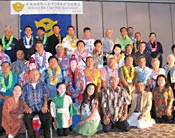
July 23, 2012 Sadao Tome Correspondent of Ryukyu Shimpo
“Go out and make the five continents into our home.” In 1898, Kyuzo Toyama, “the father-figure of Okinawan immigrants,” and 26 migrant workers from Kin Town arrived in Hawaii. In 1902, Kyuzo’s younger brother, Matasuke, landed in San Francisco. In 2002 at Quiet Cannon in Montebello City, the North America Kin Chojinkai Club held a ceremony to commemorate the 100th anniversary of immigration from Kin Town to North America. On July 1, the North America Kin Chojinkai Club held a commemorative function for the 90th anniversary of the club’s foundation.
More than 200 people, including club members from Southern California, Mayor Takeshi Gibu from Kin Town, Chairman Zenko Nakazato of the Town Council, five ward mayors, and 47 performers participated in the ceremony.
There are town and village clubs in Hawaii, Peru, and Brazil. However, the Kin Chojinkai in the vicinity of Los Angeles is the only town club in North America.
Isao Ikehara directed the planning of the ceremony, and Takeo Kaneshiro, former president of North America Kenjinkai, proposed a toast. Mayor Gibu presented a commemorative gift and money to the club and a letter of appreciation to club members aged 90 or older. Grand Master Keiko Yonaha and her students from a Ryukyuan Performing Arts group in North America, Tamagusuku-ryu Kansenkai, interacted with the performers from Kin Town.
There are unique local traditional performing arts handed down through the years in Kin Town such as musunainai, and shishimai and naginata. At the ceremony, Mirai Ige and Mirai Oshiro from Yaka Ward danced the onna bushi beautifully and entertained the audience. It was the first performance of its type to be held outside Okinawa. Chieko Omichi, an instructor of the Prefectural Police Junior Sports Kendo Club also participated in the ceremony.
Kin Town is known as the base of Okinawan migration promoted by Kyuzo and Matasuke Toyama. In his speech, Mayor Gibu stressed the inheritance of the “Kin Spirit” from the father of Okinawan migrants saying that, “I hope that youth people from the North American Kin Chojinkai and Kin Town maintain and strengthen the bond through youth trainee exchange programs and serve as a bridge between the United States and Japan.
(English translation by T&CT, Megumi Chibana and Mark Ealey)
Go to Japanese
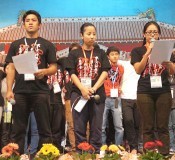
July 30, 2012 Akiko Yasuhara Correspondent of Ryukyu Shimpo in Brazil
On July 28, the closing ceremony of the 1st Worldwide Youth Uchinanchu Festival was held at the Okinawa Kenjin-Kaikan in Sao Paulo, Brazil. About 150 people participated in the festival from seven countries, discussing how to take advantage of the younger generation’s Uchinanchu network and expand the use of the Okinawan dialect.
At the closing ceremony, Minami Tamamoto the secretary-general of the Okinawa headquarters, Erika Tsukayama, the deputy secretary-general of the Okinawa headquarters, and Chuei Matsudo the head of the Brazilian branch, read out the declaration in Japanese, Spanish and Portuguese. Young people are going to create a database of information on Uchinachu all over the world and thereby facilitate interchange between generations to stimulate young people’s interest in Okinawan culture.
The declaration will be submitted to Prime Minister Yoshihiko Noda and Okinawa Governor Hirokazu Nakaima in August. The second festival will be held in the United States, in September 2013.
Summary of the declaration
Declaration summarized in the international conference of the 1st Worldwide Youth Uchinanchu Festival in Brazil as follows:
Taking advantage of the sustainable network of Uchinanchu:
1) To create a support system for Okinawa Prefectural Government-sponsored students and Municipal Office-sponsored trainees in Okinawa and abroad;
2) To create a database of Uchinanchu information in Okinawa;
3) To hold the 2nd Worldwide Youth Uchinanchu Festival in the United States.
Uchinaguchi promotion activities: To provide opportunities for exchange between the generations so young people can learn Uchinaguchi.
Creation of new culture: To ask Kenjin-Kai organizations abroad to support efforts to resume the Okinawa Prefectural Government program to dispatch of teachers from Okinawa to locations overseas and to provide opportunities for exchange between generations for young people in order generate interest in Okinawan culture.
(English translation by T&CT, Mark Ealey)
Go to Japanese
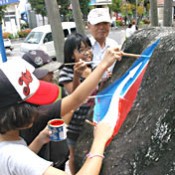
August 4, 2012 Ryukyu Shimpo
On July 27, Eiju Miyara from Miyara, Ishigaki and four pupils from Miyara Elementary School repainted the 730 (representing July 30) monument and cleaned the surrounding area to commemorate the anniversary of July 30, 1978, when the road rules switched from people driving on the right-hand side of the road to the left.
At that time, Miyara was working in the Traffic Division of Yaeyama Police Station and was involved in traffic reform.
Miyara designed the monument, which was built in September 1978, so it has a special meaning for him. Six or seven years ago, when Miyara saw tourists taking photographs in front of the monument he realized that it had became a sightseeing spot and thought of cleaning it up and repainting it. Since then, every year, as July 30 approaches, Miyara repaints and cleans up the monument with children from Miyara Elementary School.
Miyara said, “This year is more meaningful than ever because it marks 40 years since the reversion to Japanese sovereignty. July 30 is the day on which we should wish for safety on the roads. My dream is to have a community with no traffic accidents.“ Ten year-old Mimi Takehara, who helped to clean the monument, said, “I thought painting it would be easy but it wasn’t. I know only a little about what happened on July 30, but I am glad that I was able to help.”
(English translation by T&CT, Megumi Chibana and Mark Ealey)
Go to Japanese











 Webcam(Kokusai Street)
Webcam(Kokusai Street)


